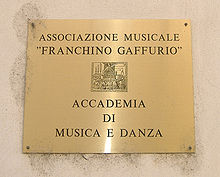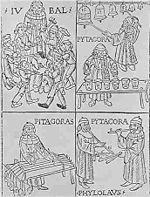
Franchinus Gaffurius
Encyclopedia

Italy
Italy , officially the Italian Republic languages]] under the European Charter for Regional or Minority Languages. In each of these, Italy's official name is as follows:;;;;;;;;), is a unitary parliamentary republic in South-Central Europe. To the north it borders France, Switzerland, Austria and...
music theorist
Music theory
Music theory is the study of how music works. It examines the language and notation of music. It seeks to identify patterns and structures in composers' techniques across or within genres, styles, or historical periods...
and composer of the Renaissance
Renaissance music
Renaissance music is European music written during the Renaissance. Defining the beginning of the musical era is difficult, given that its defining characteristics were adopted only gradually; musicologists have placed its beginnings from as early as 1300 to as late as the 1470s.Literally meaning...
. He was an almost exact contemporary of Josquin des Prez
Josquin Des Prez
Josquin des Prez [Josquin Lebloitte dit Desprez] , often referred to simply as Josquin, was a Franco-Flemish composer of the Renaissance...
and Leonardo da Vinci
Leonardo da Vinci
Leonardo di ser Piero da Vinci was an Italian Renaissance polymath: painter, sculptor, architect, musician, scientist, mathematician, engineer, inventor, anatomist, geologist, cartographer, botanist and writer whose genius, perhaps more than that of any other figure, epitomized the Renaissance...
, both of whom were his personal friends. He was one of the most famous musicians in Italy in the late 15th and early 16th centuries.

Life
He was born in Lodi to an aristocratic family. Early in life he entered a BenedictineBenedictine
Benedictine refers to the spirituality and consecrated life in accordance with the Rule of St Benedict, written by Benedict of Nursia in the sixth century for the cenobitic communities he founded in central Italy. The most notable of these is Monte Cassino, the first monastery founded by Benedict...
monastery, where he acquired his early musical training; later he became a priest
Priest
A priest is a person authorized to perform the sacred rites of a religion, especially as a mediatory agent between humans and deities. They also have the authority or power to administer religious rites; in particular, rites of sacrifice to, and propitiation of, a deity or deities...
. Later he lived in Mantua
Mantua
Mantua is a city and comune in Lombardy, Italy and capital of the province of the same name. Mantua's historic power and influence under the Gonzaga family, made it one of the main artistic, cultural and notably musical hubs of Northern Italy and the country as a whole...
and Verona
Verona
Verona ; German Bern, Dietrichsbern or Welschbern) is a city in the Veneto, northern Italy, with approx. 265,000 inhabitants and one of the seven chef-lieus of the region. It is the second largest city municipality in the region and the third of North-Eastern Italy. The metropolitan area of Verona...
before settling in Milan
Milan
Milan is the second-largest city in Italy and the capital city of the region of Lombardy and of the province of Milan. The city proper has a population of about 1.3 million, while its urban area, roughly coinciding with its administrative province and the bordering Province of Monza and Brianza ,...
as the maestro di cappella at the cathedral there, a position which he accepted in January 1484.
During the previous decade the Sforza family, using the composer Gaspar van Weerbeke
Gaspar van Weerbeke
Gaspar van Weerbeke was a Netherlandish composer of the Renaissance. He was of the same generation as Josquin des Prez, but unique in his blending of the contemporary Italian style with the older Burgundian style of Dufay.- Life :...
as a recruiter, had built the choir at their chapel in Milan into one of the largest and most distinguished musical ensembles in Europe: composer-singers such as Alexander Agricola
Alexander Agricola
Alexander Agricola was a Franco-Flemish composer of the Renaissance. A prominent member of the Grande chapelle, the Habsburg musical establishment, he was a renowned composer in the years around 1500, and his music was widely distributed throughout Europe...
, Loyset Compère
Loyset Compère
Loyset Compère was a French composer of the Renaissance. Of the same generation as Josquin des Prez, he was one of the most significant composers of motets and chansons of that era, and one of the first musicians to bring the light Italianate Renaissance style to France.-Life:His exact place of...
and Johannes Martini
Johannes Martini
Johannes Martini was a Franco-Flemish composer of the Renaissance.-Life:He was born in Brabant around 1440, but information about his early life is scanty. He probably received his early training in Flanders, as did most of the composers of his generation...
had all been employed there. While the membership of the choir at the Milan cathedral was mostly Italian, the cross-influence between his choir and the group at the Sforza chapel was significant. Gaffurius retained the post at the cathedral for the rest of his life, and it was in Milan that he knew both Josquin des Prez and Leonardo da Vinci.
Writings

Humanism
Humanism is an approach in study, philosophy, world view or practice that focuses on human values and concerns. In philosophy and social science, humanism is a perspective which affirms some notion of human nature, and is contrasted with anti-humanism....
bent. In addition to having a thorough understanding of contemporary musical practice, he met composers from all over Europe, since he had the good fortune to be living and working at one of the centers of activity for the incoming Netherlanders. His books have a pedagogical intent, and provide a young composer with all the techniques necessary to learn his art.
The major treatises of his years in Milan are three: Theorica musicae (1492), Practica musicae (1496), and De harmonia musicorum instrumentorum opus (1518). The second of these, the Practica musicae, is the most thorough, proceeding through subjects as diverse as ancient Greek notation, plainchant, mensuration, counterpoint
Counterpoint
In music, counterpoint is the relationship between two or more voices that are independent in contour and rhythm and are harmonically interdependent . It has been most commonly identified in classical music, developing strongly during the Renaissance and in much of the common practice period,...
, and tempo
Tempo
In musical terminology, tempo is the speed or pace of a given piece. Tempo is a crucial element of any musical composition, as it can affect the mood and difficulty of a piece.-Measuring tempo:...
. One of his most famous comments is that the tactus, the tempo of a semibreve, is equal to the pulse of a man who is breathing quietly—presumably about 72 beats per minute.
Music
Gaffurius wrote massMass (music)
The Mass, a form of sacred musical composition, is a choral composition that sets the invariable portions of the Eucharistic liturgy to music...
es, motet
Motet
In classical music, motet is a word that is applied to a number of highly varied choral musical compositions.-Etymology:The name comes either from the Latin movere, or a Latinized version of Old French mot, "word" or "verbal utterance." The Medieval Latin for "motet" is motectum, and the Italian...
s, settings of the Magnificat
Magnificat
The Magnificat — also known as the Song of Mary or the Canticle of Mary — is a canticle frequently sung liturgically in Christian church services. It is one of the eight most ancient Christian hymns and perhaps the earliest Marian hymn...
, and hymn
Hymn
A hymn is a type of song, usually religious, specifically written for the purpose of praise, adoration or prayer, and typically addressed to a deity or deities, or to a prominent figure or personification...
s, mainly during his Milan years. Some of the motets were written for ceremonial occasions for his ducal employer; many of the masses show the influence of Josquin, and all are in flowing Netherlandish polyphony
Polyphony
In music, polyphony is a texture consisting of two or more independent melodic voices, as opposed to music with just one voice or music with one dominant melodic voice accompanied by chords ....
, though with an admixture of Italian lightness and melody. His music was collected in four codices under his own direction.

